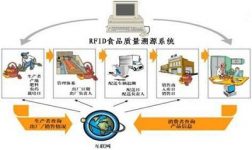
Laotong Maca brand health products use RFID technology for anti-counterfeiting
[ad_1]
Since the “Sanlu Milk Powder” incident, China’s food safety issues have become increasingly severe. From the national quality supervision to the people’s table consumption, everyone is concerned about food quality and safety. Problems such as “waste oil”, “clenbuterol”, and “plasticizer” are gradually exposed. People have to consider the impact of each consumption on their health, and pay special attention to the source of food, including clarifying the procurement of raw materials, production and processing, and Responsibilities for all aspects of logistics, transportation, and wholesale sales.We must rely on the latest information technology to realize the whole-process tracking and supervision of food. This plan proposes to adopt the latest Internet of Things RFID technology, stick RFID electronic tags to each food packaging tracking unit, and realize automatic identification and collection in a timely and accurate manner throughout the process.RFIDLabel information, and transmit the information to the back-end database in real time, so that consumers and regulatory authorities can track the source of food, make it easier for manufacturers to implement quality responsibilities, protect the product quality and brand reputation of manufacturers, and prevent counterfeiting and cross-selling.At present, we have established an NFC anti-counterfeiting and anti-smuggling cloud platform in cooperation with Laotong Maca brand health products, adoptingNFCThe high-frequency tag encryption digital signature technology supports NFC mobile phones to directly identify the NFC anti-counterfeiting tags built into the product. Brand protection has a long way to go, and NFC anti-counterfeiting is more secure and reliable than any previous anti-counterfeiting method.

System planning:
Assign a unique UHF RFID logistics label (combined with a variable QR code) to each food packaging box, deploy an RFID reader (or RFID handheld) in each monitoring link, and the RFID reader will automatically Identify and upload the RFID logistics tag data entering the area to the back-end database. Any clues will leave an accurate log. For illegally moving food packaging boxes, a warning message can be issued to the staff on duty immediately. Sampling inspection or inventory personnel take RFID handhelds to on-site inspection or inventory, using the technical advantages of RFID long-distance batch identification, combined with WIFI/3G/4G mobile Internet, and the data is transmitted to the back-end database in real time. Consumers or regulatory authorities can use their mobile phone WeChat to scan and inquire, and trace the source of food at any time.
The food mentioned in this plan includes, but is not limited to, agricultural products, edible oil, milk powder and other essential foods. We will formulate a specific RFID quality traceability system implementation plan based on different food types, production packaging, and storage and transportation units. The design is aimed at Flexible RFID electronic tag specifications and shapes, equipped with appropriate RFID readers and software modules.
The system consists of five parts:
1. Issuing labels: A logistics tracking label containing an RFID electronic chip is issued to the food packaging box as the unique identification of each box of food. The ID of the RFID electronic tag can establish a unique correspondence with the company’s existing ERP system, logistics storage system, bar code and variable QR code of the retail POS system of the company, which is convenient for the integrated application of the RFID system and the old system, and avoids data duplication. Entry increases the workload of personnel.
2. Sampling inspection: You can take the RFID handsets to conduct spot checks on site. The RFID handsets are connected to the network via WIFI, and the scanned RFID tag information can be compared with the information in the back-end database in real time, and the spot-check information is immediately updated to the back-end database and data No need to re-enter manually. In addition, the work of inspectors is also an accurate quantitative tracking. Because RFID tags are unique, inspectors must go to the scene to collect RFID tags, which can avoid job omissions and deliberate coping.
3. Food tracking: When the food passes through the monitoring area of any RFID reader (or RFID handset) in the circulation link, it will be automatically identified and recorded in the back-end database. If the food is not in the authorized supervision area, there will be an alarm message reminder manager.
4. WEB query statistics: The management personnel of food manufacturers can query the issuance of RFID food labels on the WEB side, query and track the whereabouts of logistics labels, check the distribution progress, statistical reports, and so on.
5. System integration: The RFID food quality traceability system can be integrated with the ERP system and logistics warehousing system in use by the enterprise through interfaces to avoid repeated maintenance of data, maximize data sharing, and protect the original IT investment.
Solution value:
This solution helps food production companies realize a 7*24-hour food quality traceability supervision mode at a low cost. The RFID food quality traceability system is automated, which can track in real time and control the flow of food quality. Compared with barcode and two-dimensional code tracking, the advantages of RFID non-contact long-distance large-scale automatic identification are more obvious, and the operation of personnel is more convenient and quick, which significantly reduces the workload of circulation management.
[ad_2]




